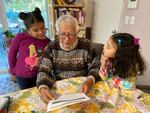In a letter dated Dec. 23, Gov. Kate Brown announced several changes she hoped would make reopening schools easier in Oregon. That included making COVID-19 health metrics for school reopenings advisory rather than mandatory.
“It is my hope that more Oregon schools, especially elementary schools, will transition to in-person instruction by February 15, 2021,” Brown wrote.
The Oregon Department of Education’s latest data states 116,749 Oregon students have at least some in-person instruction.
In a statement on Monday, Brown said that’s double the number of students learning in person back in December.
“I am thrilled to see so many of Oregon’s school districts and teachers working hard to help return our children to the most effective learning environment: in-person, personalized education,” Brown said in Monday’s statement. “Now, middle and high school students must get the same chance, so that all students have the opportunity to benefit from in-person instruction, regardless of the community in which they live.”
Brown pointed to state and federal funding to help school districts, as well as updated guidance from the Centers for Disease Control and Prevention on reopening schools.

Oregon Gov. Kate Brown speaks during a news conference on the coronavirus outbreak, March 16, 2020.
Kaylee Domzalski / OPB
Some school districts have already started sending students back into the classroom. Others have laid out reopening plans, and are surveying families.
The results have been mixed.
In the Woodburn School District, school staff called every family to ask whether they preferred to stay in distance learning or move to hybrid. The response was close to evenly split — showing the deep divide in some communities when it comes to worry about exposure to the virus and a desire to return to a traditional school environment.
According to the Woodburn survey, 2,484 students preferred to continue distance learning, while 2,540 students preferred moving to a hybrid model. There was no response, or no preference from 194 students.
The district asked families to make their decisions by Feb. 12, with a week to change or ask questions about the preferred instructional model.
The Reynolds School District surveyed families too, and 51% of elementary families chose hybrid, with 17% choosing to remain in distance learning, and 32% choosing “not sure yet.”
In Portland and Beaverton, two of Oregon’s largest school districts, the earliest students will be back in classrooms is early April, though both districts are offering limited in-person instruction.
Portland began surveying parents Friday about returning to school. PPS asks that families respond to the survey by Feb. 22.
In Beaverton, elementary parents had to let the district know by Feb. 15 whether their students would remain in distance learning or switch to a hybrid-learning model. On Feb. 15, the district extended the deadline to Feb. 18. If families decline to make a choice, the district said the student will automatically remain in distance learning.
And despite Brown’s hope to have elementary students learning in classrooms, it’s not just the Reynolds and Woodburn districts where a number of families aren’t ready to return yet.
For elementary parent Karen Perez-Da Silva, staying home is a matter of keeping her family safe from COVID-19.
“In making our decision about whether we go back or not, we had to prioritize my parents’ health and my daughter’s health,” Perez-Da Silva said. “We were worried that they might get sick and then bring it home.”
But that doesn’t mean it was an easy decision.
“For the girls it’s been really hard to not have the teacher in person, to not have friendships – being able to play with other kids,” Perez-Da Silva said.

Amayah and Yara, Karen Perez-Da Silva's daughters, look at schoolwork with Perez-Da Silva's father. While Amayah and Yara want to return to school, they will finish the year in distance learning out of safety concerns for their grandparents and Yara, who has asthma.
Courtesy of Karen Perez Da Silva
Her third-grader, Amayah, has had a hard time in distance learning.
“I haven’t made any friends,” she said.
But Amayah said she understands why her family has decided not to go back to school. So does her older sister, Yara, who has asthma.
“I wish I could go back to school, but because of all the conditions, and because of my grandparents, I can’t go back to school,” Yara said.
Perez-Da Silva, who is running for the Beaverton school board, says she’s heard concerns about returning to the classroom from parents in her school’s Latino parent group too.
The worries range from having families as first responders, to having access to vaccines, to finding child care.
“If one of our students gets sick, and you have to take two weeks off to care for your child,” Perez-Da Silva said.
Beaverton parent Liz Delapoer says she’s planning to keep her two children in distance learning for the rest of the year, too.
“For us, the decision to stay with CDL [Comprehensive Distance Learning] means less change — they’ll still have their routine at home, their day will look very similar,” Delapoer said.
Delapoer said her third-grade student opted to stay at home after learning they’d only be with teachers for 2 hours and 15 minutes a day, without recess or lunch.
Delapoer struggles with making a decision now about how school will look for her students in two months’ time.
She also struggles with an aspect of the district’s reopening plan that will impact all students, regardless of whether they’re at home or at school — they may have a different teacher for the rest of the year.
“The first-grader just wanted to desperately stay with his teacher, who he loves,” Delapoer said.
“When we told him he might not get to stay with her, he sobbed at the dinner table.”
The district said it will try to maintain current teacher-student relationships. The district is surveying teachers on whether they may be at “high-risk” for severe illness from COVID-19, but the district said it will not ask teachers whether they prefer to return to the classroom.
Parent Eleissa Buddress plans to send her fourth-grader back into a school building when the time comes, no matter what. But she also expressed concern about her daughter, who has struggled with mental health, not having the same teacher she’s had all year.
“These teachers have dialed this all in, and to have this upheaval and disruption in teacher continuity for two months,” Buddress said. “I understand the drive to get kids back to school ... my kid’s seeing a therapist right now, if anyone wants her back it’s us, I get it — but I’m also thinking about the ramifications of having everything kind of upended.”
Buddress’ other student is in 7th grade, and Beaverton has not announced plans for its middle or high schools. They will Friday. The district will begin offering Limited In-Person Instruction to a small number of students Feb. 22.
Bradi Knight Gates also has older students in the district — a student in middle school and a student in high school. She said they’re waiting to go back as soon as the option is available.
“They see their friends...and family in different states that have returned recently or have been going to school for months and are a little confused why they can’t have that, too,” Knight Gates said.
“They do try to understand what’s going on, and we try to have mature conversations without being negative about the situation, but they’ll both tell you they want to go back.”
Seeing older students in Oregon head back to the classroom is something Gov. Brown wants, too.
“Our students only grow up once. We cannot let the school year end with the class of 2021 never having set foot in Oregon high schools,” Brown wrote.
“I know that some have had their doubts. But we can do this, by continuing to work together. It is within our power to provide every Oregon student the opportunity for in-person instruction this school year.”
But COVID-19 has not gone away. And while public health experts say schools are not a huge risk for spread of the virus, they’re not immune to it. Since Oregon schools started reopening over the last several months, hundreds of cases have been detected among students and staff.
In the first week back to in-person learning, Bend La-Pine’s Summit High School students had to return back to distance learning due to a COVID-19 outbreak, according to the Bend Bulletin.
This story has been updated to include new information on Beaverton’s deadline announced Feb. 15.